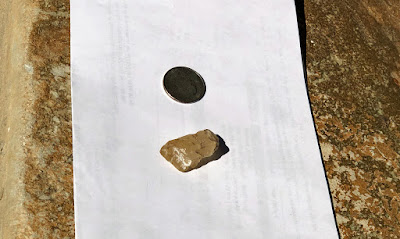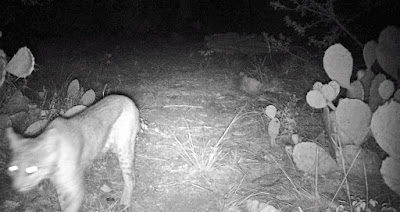There is a lot of sun in our part of Texas for a lot of the year, and we just could not bear to think of all of that free sunlight falling on our roof and not benefiting us in any way; so we decided to have some solar panels put up on said roof to turn all of that wasted sun-energy into useful electrical energy for us and our cats. But before we get to that we must talk about...
The Unplanned Hole
This is the unplanned hole.
Recently, we discovered another leak in our irrigation PVC. This marks the third such leak, as seen in this Episode and this Episode.
As in one of the previous cases, this leak was caused by a stress fracture in the very thin-walled PVC. Either our lawn's dirt has settled over the years, or the install was not quite 100%, or both.
Thus, the unplanned hole to confirm and locate the leak. This is the offending section of pipe. You would think that repairing such a small section of PVC would be simple.
But no. We had to have enough room to add all of the normal couplers and the expansion coupler; and in this case the crack was right next to the T-junction, so we had to replace the entire junction assembly, which led to even more digging.
Additionally, we had to work around the irrigation wiring, and another pipe running through the same unplanned hole.
In the end we had to dig up quite a bit to allow room for the T-junction replacement, and for the addition of the expansion coupler - all while avoiding damage to the wiring and the other pipe.
Here is the final repair, before the unplanned hole was filled in. As usual, we left the damaged, defective PVC in the hole for future archaeologists to ponder.
Solar System One
As it turns out, the previous owners of our Texas House are directly related to the co-founder of a local solar system company.
Just think - in that box is a bunch of free electricity!
These are the actual panels, pre-installation. In total, we have 36 panels installed, and the system is rated for about 11.5kw.
Two meters? Helpfully, they are clearly labelled.
This is a new box.
This is the energy generation chart from October. To date, we have saved the equivalent of 3,071.67 pounds of CO2 emissions, which is apparently the equivalent of planting 23.21 trees. How does one plant 0.21 trees?
Lighting
Imagine my surprise when I walked through the laundry room area and found this...
I'm pretty sure this wasn't like this when we moved in...
The good news is that the wire nuts held and the light fixture did not fall to the earth.
I think I've found the problem. It seems that the screw holes have been damaged, and the screws have slipped out. The junction box was damaged beyond repair, and it needed replacing.
Please note that the breaker was turned off before any work was done on this light fixture.
The Other Unplanned Hole
Measuring with the tape measure seemed to show that I would be able to access the light fixture through the attic floor, and thus avoid having to cut into the ceiling.
Here on the New House Blog we do not hide our mistakes (for the most part), so I must now admit my mistake, which I discovered only after removing a section of attic floor. Do you see the arrow in the picture? It is pointing to where the light fixture actually is - way off yonder under a different part of the floor. It turns out that I made a mistake with my measurements, and I could not access the light fixture from above without removing a bunch of plumbing and insulation, and possibly falling through the ceiling. D'oh!
A phone call to an electrician brother provided me with some excellent advice about how to replace the junction box without having to cut into the ceiling, and a quick trip to the local Home Depot provided me with the necessary junction box and the correct screws.
The junction box replacement was successful, wires were re-spliced (yes I included my signature yellow electrical tape), the fixture was re-affixed, and I did not have to cut into the ceiling.
Hole in the attic floor? What hole in the attic floor. I don't see any holes. No holes here...
Behold: the actual screws that were previously used to hold the light fixture to the ceiling.
Solar System Two
Our Texas House came with a large mess of branches and debris that was preventing solar energy (sunlight) from reaching the ground. I decided to remove this solar impediment.
Meet the leaned-over, mostly-dead tree limb that was blocking a bunch of sunlight. This photo was taken after I removed all of the pesky smaller branches.
Look at all of that solar energy hitting the ground! It is so much nicer to have that pesky tree out of the way. Yes, I got permission from our neighbor to cut the limb a ways back onto his property.
Mr. Sawzall performed beautifully, and I swapped blades frequently to keep them from overheating too much. We now have a nice pile of potential firewood.
Solar System Three
Plants are solar powered, and we added several recently.
The severly cropped plant in the center of this picture is called a Texas Sotol (Dasylirion Texanum), and while we have no particular dislike of this plant, in general, this particular specimen just did not fit where it was planted. Not to worry, though, as we have another, larger Texas Sotol that fits much better into its allotted space.
No more Texas Sotol. But that is a lot of empty space. What to do...
Give a big Texas shout out to our new Octopus Agave (Agave Vilmoriniana).
As you can see, it fits in very well with the already extant plants.
Bonus fact: whilst digging the first hole for this agave we discovered a drain pipe right in the center of the hole, so we had to fill in that hole and dig another (unplanned) planting hole.
Remember what I said earlier about not hiding our mistakes? Well, I made a second mistake. In my mind I thought we had room for two plants where the old Texas Sotol had been, so I picked up this Grey Ghost Organ Pipe Cactus (Stenocereus Pruinosus) at the same time I picked up the octopus agave. However, I erred, and it does not fit in the space with the new octopus agave, so we found another, possibly better, place for it near our false saguaro (pachycereus pringlei).
As with the planting of said octopus agave, we had to dig two holes to successfully plant our grey ghost organ pipe cactus - the first hole had some irrigation PVC running through it, so we had to dig a second, unplanned hole to successfully plant our grey ghost organ pipe cactus. The nursery staff advised leaving the bamboo stakes in for its first month in the ground.

Next up on our planting list are these two trees - a Methley Plum (Prunus Salicina 'Methley') to the left of the pepper plants, and a Blenheim Apricot (Prunus Armeniaca 'Blenheim') to the right. Keep looking - they're there. You're looking for the two tall, skinny stick-like things sticking up from the ground. They both have new leaves since this photo was taken.
Because the tags on the plum trees recommended a second one, for pollination purposes, we planted this Bruce Plum (Prunus 'Bruce').
Look at all of that solar energy being collected! And look at that deer cage!
The planting guide we looked at recommended planting plum trees 15 feet apart. Ours are closer to 16.5 feet, but we think they should still be ok for pollination.
Workbenches
Meet workbench number one. Actually, it is more of a light table than a workbench. It is made from an old clothes hamper, a random piece of plywood, and some random screws to hold it all together. It replaces a stack of storage tubs that I had been using as a table.
Meet workbench number two. It is closer to being a proper workbench, and I use it as such (I have even had my
big, blue vice on it at least once). The base is two sawhorses. The work surface is made from lumber left over from our
garden fence project.
As you can see, the work surface is split into two sections (and they are quite heavy sections), for greater flexibility and easier storage if I need the sawhorses for something else.
Solar System Four
We conclude this Episode with a brief Back Yard Archaeology (BYA) update. What does that have to do with solar energy? Well, the following photographs were lighted with 100% pure solar energy.
This spoon, was discovered somewheres on the property, but I don't recall where - possibly while planting our octopus agave. Here you see the obverse (lighted with solar energy).
And this is the reverse (also lighted with solar energy). It is a plain, unremarkable spoon made from some type of metal. It has been cleaned, sanitized, and added to our spoon arsenal.

Finally, we have this chunk of what I believe to be some genuine Texas topaz (the quarter is for scale, and may be what this topaz is worth). Look at how it catches all of that solar energy. I found this in the back yard, just sitting on the surface. Possibly my digging in the garden area had unearthed it and it had been sitting for a while, or possibly a small critter carried it from a far away location.
Keep on the sunny side, always on the sunny
bIsh




























































